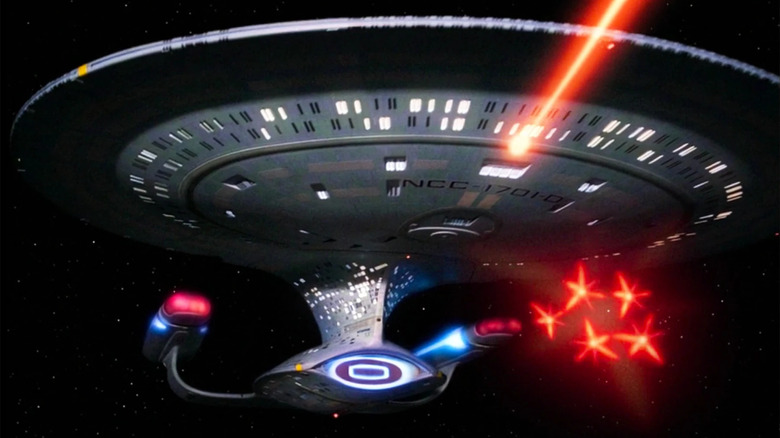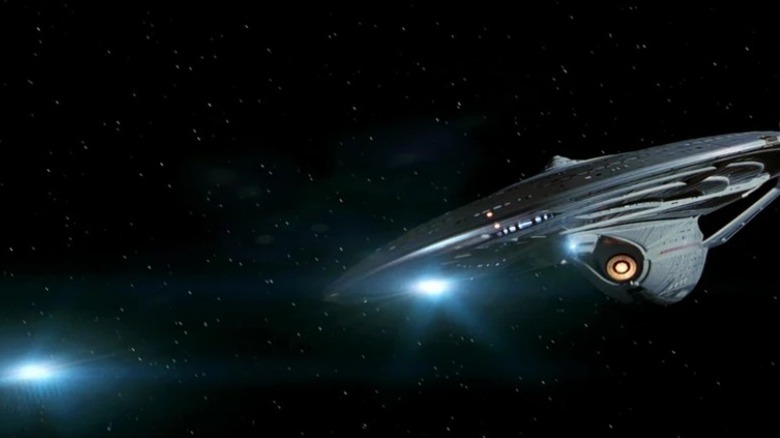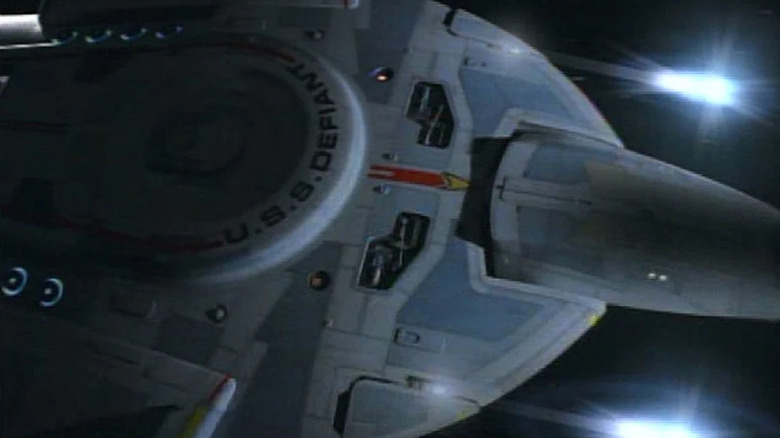The Difference Between Star Trek's Photon Torpedos And Quantum Torpedos, In Plain English
The U.S.S. Enterprise is, as any good Trekkie could tell you, a vessel of research, diplomacy, and exploration. Whichever "Star Trek" series you prefer, each Enterprise is going to be equipped with state-of-the-art computer systems, high-powered engines that allow it to travel many, many times the speed of light, and no end of medical facilities, research labs, schools, diplomatic quarters, arboretums, bowling alleys, and at least one tavern.
And, because there are unknown hostilities out in the cosmos, Starfleet vessels are also equipped with high-powered weapons. In a battle scenario, the Enterprise is usually seen firing phasers — a beam-like energy weapon — as well as physical photon torpedoes. While on board, photon torpedoes are depicted as elongated, black, coffin-sized weapons that are physically loaded into one of the ship's multiple launchers. When launched, photon torpedoes appear as red, glowing balls of light that crash into their targets with explosive force.
At some point during "Star Trek: Deep Space Nine," however, talk of photon torpedos came to an end, as they had seemingly been replaced by something called quantum torpedoes. Quantum torpedoes glowed white and moved more quickly through space. They were the standard weapon on board DS9's ship, the U.S.S. Defiant, a vessel built for attack. After that, most starship torpedos became quantum torpedoes.
What is the difference? Well, sadly, it seems that few scripted "Star Trek" shows have bothered to explain what separates a photon torpedo from a quantum torpedo. Luckily, enterprising nerds and "Trek" writers have explained what they are in ancillary expanded universe materials like technical manuals, and in interviews. It is an immutable rule of nature that no detail of "Star Trek" is going to go unexplored.
Photon torpedoes
In the early 1990s, producer and screenwriter André Bormanis worked as the science consultant on "Star Trek: The Next Generation," and would go on to serve on "Star Trek: Deep Space Nine" and "Star Trek: Voyager" as well, so he was there for the transition from photons to quantums. In a 2011 interview with the BBC, Bormanis was grilled about all the small technical details on "Star Trek," and revealed some interesting details. He revealed that the photon torpedoes on "Next Generation" — set about a century after the events of the original series — were far more powerful than the ones on Kirk's ship. He also had a good analog for the torpedoes in terms of earthbound, modern-day weapons. Bormanis said:
"Photon torpedoes have a greater yield, it's a more powerful bang than it was in the original series. Then on 'Deep Space Nine,' we suggested a new invention called a quantum torpedo and, presumably, that was kind of like the difference between an A-bomb and an H-bomb. This is an even more powerful torpedo weapon that could disrupt matter at a quantum level. We've never worked out in any detail how because it's beyond present day science. Photon torpedoes were more conventional kind of explosive weapon that incorporated matter and antimatter explosions."
If photon torpedoes employed matter/antimatter explosions, why aren't they called antimatter torpedoes? How do photons — particles of electromagnetic radiation — enter into it? Well, according to "The Star Trek: The Next Generation Technical Manual," photon torpedoes employed deuterium, which is a stable hydrogen isotope, which was activated by antideuterium, very similar to a reaction in a nuclear explosion. "The Next Generation"-era photons added magnetic packets into the process, speeding up the explosion and increasing the damage. It seems "photon" refers to photonic radiation.
Quantum torpedoes
The technology of quantum torpedoes, meanwhile, is far more complex ... and steers directly into utter jargon. From "The Star Trek: Deep Space Nine Technical Manual," authors Rick Sternbach, Doug Drexler, and Herman Zimmerman wrote the following description (and be warned, none of this will make much sense):
"The quantum warhead relies on rapid energy extraction from zero-point vacuum. This is established from an 11-dimensional space-time membrane, twisted into a Genus-1 topology string, housed inside the ultraclean vacuum of a 1.38 meter-long teardrop shaped zero-point field reaction chamber. The detonation of a photon torpedo warhead, enriched with fluoronetic vapor, inside the torpedo powers a continuum distortion emitter. It expands the membrane and pinches it out of the background vacuum. The membrane forms into subatomic particles accompanied by a high-explosive energy release."
Which is all a fancy way of saying it explodes better. Notably, terms like "zero-point vacuum," "11-dimensional" and "topology strings" are all terms cribbed from actual quantum mechanics. "Star Trek" has always been good about extrapolating elements of its fictional technology from actual scientific principles, merely expanding them to match the fantastical sci-fi world in which it is set.
In both cases, torpedos are equipped with miniature high-powered engines that can propel them at great speeds, as well as computers that can track targets. Quantum torpedoes can travel at warp speeds when fired at warp thanks to a "hand-off" warp field produced by induction coils.
All of this is aggressively technical, of course, but then the well-thought-out engineering detail is one of the more appealing aspects of "Star Trek." Nerds can zero in on technology, on computer panels, and on jargon, and start to get a sense as to how the ship operates ... and maybe entertain the notion that they, too, could operate the Enterprise.


